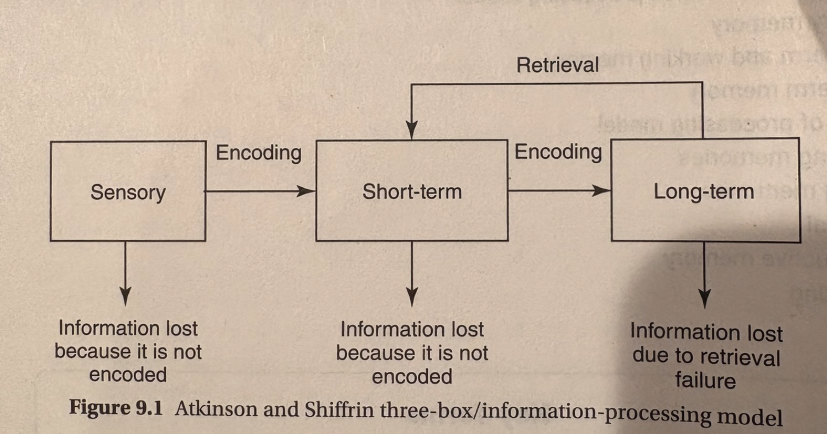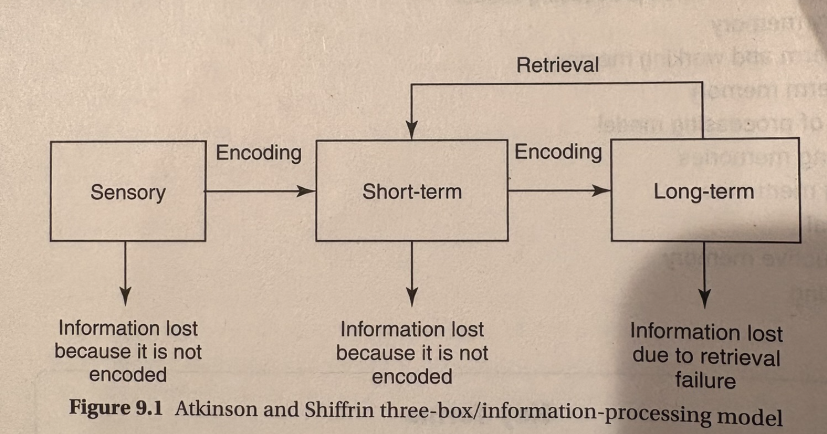apsych c9--memory
1/18
There's no tags or description
Looks like no tags are added yet.
Name | Mastery | Learn | Test | Matching | Spaced |
|---|
No study sessions yet.
19 Terms
first part of the three box/information processing model/multi-store model (pg 72 for pic)
first, external events get held in the “sensory memory” area for a very short period of time (less than a second for visual info, aka iconic memory, and a few seconds for auditory info, or echoic memory)
small amount goes to short term memory as visual codes, acoustic/sound codes, or semantic codes (a sense of meaning of the event)

inattentional blindness
we may have inattentional blindness when we don’t see something that was in front of us because we focused on something else
change blindness
we do not observe an obvious change in our visual world because we are not paying attention
working memory and its parts (pg 72)
we use our working memory to do something with information in our short-term memory (like seeing two numbers, but then trying to divide them), otherwise it usually does not move any farther in the process
working memory system involves:
central executive: monitors incoming info and determines what other systems need to process it
visuospatial sketchpad: looks at visual info
auditory loop: for words/numbers

how do we retain information
information can be retained through repetition (maintenance rehearsal) or effortful processing (putting effort into encoding the meaning of a term)

long term memory (pg 74)
long term memory is our storage and usually stays forever

explicit/declarative memories
those of facts we try to remember and implicit memories are unintentional memories we forget we have
prospective memory
remembering to do things later, like take acne meds every morning
levels of processing model
we remember things based on how much time we spend processing it, shallowly encoded vs deeply encoded
long term potentiation is the idea that neurons can strengthen connections between each other as they fire again and again
how do we encode memories
we encode memories, or put information into memories, typically by when hearing the first part of a list (primacy effect) or last part (recency effect) which together create the serial position effect (the recall of something is affected by the order
different ways to memorize things
can use method of loci to associate places with items on a list, spacing effect as well (opposed to mass practicing, aka cramming) and chunking, or grouping items into lil groups
storing memories/amnesia
some people have anterograde amnesia so they can recall old memories but not make new ones, whereas others have retrograde amnesia which is the opposite
retrieval cues
stimuli that help us retrieve memories
two types: recognition and recall
recognition vs. recall
recognition—process of matching a current event or fact with one already in memory, like asking yourself if you’ve tasted a coffee brand before
recall—retrieving memory because of something external
context-dependent memory
remembering the context of an event because it was significant (remembering the temperature during graduation)
mood-congruent
we remember things when we are in a similar mood as we were during the previous time
state dependent
we remember things in a state of consciousness like the one we had in the previous time
constructive memory
sometimes people remember things they have suppressed like trauma that can become constructed memories—they don’t have 100% accuracy
two types of interference pg. 77—retroactive vs proactive
we sometimes have information in our memory competing with what we are trying to recall
retroactive: learning new information is easier to recall than old information
proactive: older information is easier to recall